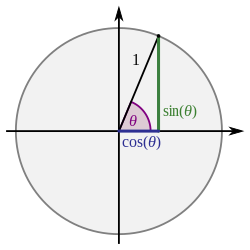सामान्यीकृत त्रिकोणमिति: Difference between revisions
m (added Category:Vigyan Ready using HotCat) |
m (27 revisions imported from alpha:सामान्यीकृत_त्रिकोणमिति) |
(No difference)
| |
Revision as of 10:20, 26 April 2023
| त्रिकोणमिति |
|---|
 |
| संदर्भ |
| कानून और सिद्धांत |
| पथरी |
सामान्य त्रिकोणमिति यूक्लिडियन तल में त्रिभुजों का अध्ययन करती है। वास्तविक संख्याओं पर सामान्य यूक्लिडियन ज्यामितीय त्रिकोणमितीय फलन को परिभाषित करने के कई तरीके हैं, उदाहरण के लिए समकोण त्रिभुज परिभाषाएँ, एकक वृत्त परिभाषाएँ, श्रेणी परिभाषाएँ, अवकल समीकरणों के माध्यम से परिभाषाएँ और फलनिक समीकरणों का उपयोग करके परिभाषाएँ। त्रिकोणमितीय फलन के सामान्यीकरण को अक्सर उपरोक्त विधियों में से एक के साथ शुरू करके और इसे यूक्लिडियन ज्यामिति की वास्तविक संख्या के अलावा किसी अन्य स्थिति में रूपान्तरित करके विकसित किया जाता है। आम तौर पर, त्रिकोणमिति किसी भी प्रकार की ज्यामिति या समष्टि में बिंदुओं के त्रिगुणों का अध्ययन हो सकता है। त्रिभुज वह बहुभुज होता है जिसके शीर्षों की संख्या सबसे कम होती है, इसलिए सामान्यीकृत करने की एक दिशा कोणों और बहुभुजों के उच्च-विमीय अनुरूपों का अध्ययन करना है: घन कोण और बहुतलीय जैसे चतुष्फलक और एन-सिंप्लिस।
त्रिकोणमिति
- गोलाकार त्रिकोणमिति में गोले की सतह पर स्थित त्रिभुजों का अध्ययन किया जाता है। गोलीय त्रिभुज सर्वसमिकाएँ सामान्य त्रिकोणमितीय फलनों के रूप में लिखी जाती हैं, लेकिन समतल त्रिभुज सर्वसमिकाओं से भिन्न होते हैं।
- अतिपरवलीय त्रिकोणमिति:
- अतिपरवलयिक फलनों के साथ अतिपरवलयिक ज्यामिति में अतिपरवलीय त्रिभुजों का अध्ययन।
- यूक्लिडियन ज्यामिति में अतिपरवलयिक फलन: एकक वृत्त को (cos t, sin t) द्वारा प्राचलिकृत किया जाता है जबकि समबाहु अतिपरवलय को (cosh t, sinh t) द्वारा प्राचलिकृत किया जाता है।
- जाइरोत्रिकोणमिति: विशिष्ट आपेक्षिकता और परिमाण अभिकलन के अनुप्रयोगों के साथ, अतिपरवलयिक ज्यामिति के लिए जायरोवेक्टर समष्टि दृष्टिकोण में प्रयुक्त त्रिकोणमिति का एक रूप।
- परिमेय त्रिकोणमिति - कोण और लंबाई के बजाय चौड़ाई और चतुष्कोण के संबंध में त्रिकोणमिति का पुनर्निमाण।[dubious ]
- टेक्सीकैब ज्यामिति के लिए त्रिकोणमिति[1]
- दिक्काल त्रिकोणमिति[2]
- अस्पष्ट गुणात्मक त्रिकोणमिति[3]
- प्रचालक त्रिकोणमिति[4]
- जालक त्रिकोणमिति[5]
- सममितसमष्टि पर त्रिकोणमिति[6][7][8]
उच्च आयाम
- श्लाफली ऑर्थोस्केम्स - सम सिंप्लेक्स (n आयामों के लिए सामान्यीकृत सम त्रिकोण) -का अध्ययन शाउट द्वारा किया गया, जिन्होंने n यूक्लिडियन आयाम बहुभुजमिति के सामान्यीकृत त्रिकोणमिति को कहा।
- एक "लंबकोणीय कोना" के साथ n-सिंप्लिस के लिए पायथागॉरियन प्रमेय
- चतुष्फलक का त्रिकोणमिति[9]
- डी गुआ की प्रमेय - एक घन कोण के साथ चतुष्फलक के लिए पायथागॉरियन प्रमेय
- चतुष्फलक के लिए ज्या का नियम
- ध्रुवीय ज्या
त्रिकोणमितीय फलन
- त्रिकोणमितीय फलनो को भिन्नात्मक अवकल समीकरणों के लिए परिभाषित किया जा सकता है।[10]
- समय मापक्रम के कलन में, अवकल समीकरणों और अवकल समीकरण को समय मापक्रम पर गतिक समीकरण में एकीकृत किया जाता है जिसमें q-अंतर समीकरण भी सम्मिलित होती है। त्रिकोणमितीय फलनों को स्वेच्छ समय मापक्रम (वास्तविक संख्याओं का एक उपसमुच्चय) पर परिभाषित किया जा सकता है।
- sin और cos की श्रेणी परिभाषाएँ इन फलनों को किसी भी बीजगणित पर एक ऐसे क्षेत्र पर परिभाषित करती हैं जहाँ श्रेणी अभिसरित होती है जैसे सम्मिश्र संख्याएं, पी-एडिक संख्याएं, मैट्रिक्स और विभिन्न बानाच बीजगणित।
अन्य
- अतिमिश्र संख्याओं के ध्रुवीय/त्रिकोणमितीय रूप[11][12]
- बहुभुजमिति - कई अलग-अलग कोणों के लिए त्रिकोणमितीय सर्वसमिका[13]
- द्विपाशी दीर्घवृत्तीय फलन, सिनलेम और कोस्लेम
यह भी देखें
संदर्भ
- ↑ Thompson, K.; Dray, T. (2000), "Taxicab angles and trigonometry" (PDF), Pi Mu Epsilon Journal, 11 (2): 87–96, arXiv:1101.2917, Bibcode:2011arXiv1101.2917T
- ↑ Herranz, Francisco J.; Ortega, Ramón; Santander, Mariano (2000), "Trigonometry of spacetimes: a new self-dual approach to a curvature/signature (in)dependent trigonometry", Journal of Physics A, 33 (24): 4525–4551, arXiv:math-ph/9910041, Bibcode:2000JPhA...33.4525H, doi:10.1088/0305-4470/33/24/309, MR 1768742, S2CID 15313035
- ↑ Liu, Honghai; Coghill, George M. (2005), "Fuzzy Qualitative Trigonometry", 2005 IEEE International Conference on Systems, Man and Cybernetics (PDF), vol. 2, pp. 1291–1296, archived from the original (PDF) on 2011-07-25
- ↑ Gustafson, K. E. (1999), "A computational trigonometry, and related contributions by Russians Kantorovich, Krein, Kaporin", Вычислительные технологии, 4 (3): 73–83
- ↑ Karpenkov, Oleg (2008), "Elementary notions of lattice trigonometry", Mathematica Scandinavica, 102 (2): 161–205, arXiv:math/0604129, doi:10.7146/math.scand.a-15058, MR 2437186, S2CID 49911437
- ↑ Aslaksen, Helmer; Huynh, Hsueh-Ling (1997), "Laws of trigonometry in symmetric spaces", Geometry from the Pacific Rim (Singapore, 1994), Berlin: de Gruyter, pp. 23–36, CiteSeerX 10.1.1.160.1580, MR 1468236
- ↑ Leuzinger, Enrico (1992), "On the trigonometry of symmetric spaces", Commentarii Mathematici Helvetici, 67 (2): 252–286, doi:10.1007/BF02566499, MR 1161284, S2CID 123684622
- ↑ Masala, G. (1999), "Regular triangles and isoclinic triangles in the Grassmann manifolds G2(RN)", Rendiconti del Seminario Matematico Università e Politecnico di Torino., 57 (2): 91–104, MR 1974445
- ↑ Richardson, G. (1902-03-01). "टेट्राहेड्रॉन का त्रिकोणमिति". The Mathematical Gazette. 2 (32): 149–158. doi:10.2307/3603090. JSTOR 3603090.
- ↑ West, Bruce J.; Bologna, Mauro; Grigolini, Paolo (2003), Physics of fractal operators, Institute for Nonlinear Science, New York: Springer-Verlag, p. 101, doi:10.1007/978-0-387-21746-8, ISBN 0-387-95554-2, MR 1988873
- ↑ Harkin, Anthony A.; Harkin, Joseph B. (2004), "Geometry of generalized complex numbers", Mathematics Magazine, 77 (2): 118–129, doi:10.1080/0025570X.2004.11953236, JSTOR 3219099, MR 1573734, S2CID 7837108
- ↑ Yamaleev, Robert M. (2005), "Complex algebras on n[[Category: Templates Vigyan Ready]]-order polynomials and generalizations of trigonometry, oscillator model and Hamilton dynamics" (PDF), Advances in Applied Clifford Algebras, 15 (1): 123–150, doi:10.1007/s00006-005-0007-y, MR 2236628, S2CID 121144869, archived from the original (PDF) on 2011-07-22
{{citation}}: URL–wikilink conflict (help) - ↑ Antippa, Adel F. (2003), "The combinatorial structure of trigonometry" (PDF), International Journal of Mathematics and Mathematical Sciences, 2003 (8): 475–500, doi:10.1155/S0161171203106230, MR 1967890